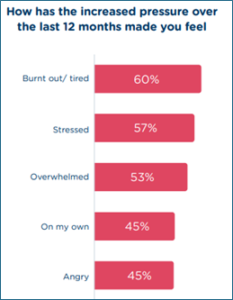Intro: Staff are bunkering down, managers are overwhelmed
Remember the quiet quitting era? It’s recent, and brief, and it’s all over!
With the tailend of ’24 coming up, Australian organisations now face a more complex staffing issue: employee retention is up while employee happiness and engagement are falling.
The pain is being felt keenly by middle managers (particularly female and regional managers), who are burnt out, stressed and overwhelmed. And nearly half are angry!
These trends, uncovered in the recent Engagement Paradox Report by Reward Gateway, present a big challenge for leaders today.
Key findings snapshot
The report comes out of a survey of 1,093 full-time employees and 1,241 business and HR leaders across Australia. Here are some critical insights:
- Retention without Engagement: Despite higher retention rates, employee engagement is at an all-time low. While nearly 45% of employees are not looking to change roles in the next two years, 74% will consider moving if economic conditions improve.
- Happiness and Recognition: About one-third of employees report low levels of happiness, driven by factors such as work-related burnout, cost of living, and lack of recognition.
- Economic Pressures: 87% of decision-makers find it challenging to meet salary expectations amidst the current economic climate, contributing to decreased engagement and satisfaction.
- Manager distress is greater in regional areas: over half (53%) of middle managers in regional and rural Australia report the increased pressures are making them feel like they are ‘on their own’ (40% in the capital cities).
So what to do? Although there’s more to wellbeing than just what’s going on at work, there’s plenty that is connected strongly to the workplace, and a lot that workplace leaders can do…
The Engagement Paradox
This challenge is linked to the economic climate, which is putting organisations under the pump while making job switching risky. So although employees are staying put, many stay on in their roles due to this job market uncertainty, reduced opportunities, and the risks entailed in changing jobs, rather than because they’re satisfied in their job or workplace.
The Cost of Low Engagement
The key drivers of engagement decline include:
- Burnout and Stress: Work-related burnout and stress are major factors.
- Cost of living pressures: This is a factor for just over half of respondents.
- Lack of Recognition: Recognition and appreciation are crucial for high morale and engagement.
Low engagement significantly impacts business performance. The report suggests that poor engagement can cost businesses between $20,000 and $100,000 each month. High engagement correlates with better performance metrics and higher customer satisfaction.
Strategies for Improving engagement and happiness
To address these challenges, leaders should focus on the following areas:
- Transparency and Communication: Maintain open communication about business goals and the economic climate. This fosters trust and helps employees understand their role in the bigger picture.
- Feedback Channels: Implement systems for feedback to understand and address employee concerns proactively.
- Learning and Growth: Invest in employee development even during downturns. Offer training programs and opportunities for career advancement.
- Recognition and Rewards: Enhance recognition programs to celebrate achievements and contributions. Ensure remote employees feel included and valued. Peer-to-peer recognition can also boost morale.
- Flexible Working: Support remote work options, which are proven to improve job satisfaction and productivity.
Managers under pressure
Middle managers are specifically affected by the current challenges, facing increased pressure to manage performance and improve engagement:
- 60% report feeling burnt out and tired,
- 57% feel stressed,
- 53% feel ‘overwhelmed’,
- 45% feel ‘on my own’.
- …and 45% are angry!
Comparatively, only 28% of senior managers report feeling overwhelmed, 33% feel burnt out and two-thirds actually feel energised by the increased pressure. It used to be said that it’s tough at the top, but now, it’s miserable in the middle!
It’s worse in regional areas
Just 47% of managers living in rural and regional areas say that the increased pressure is making them feel part of a supportive team, compared to60% of middle managers in capital cities.
And the proportion of middle managers who say the increased pressure makes them feel like they are ‘on their own’ is over half (53%) for those living outside of capitals, compared to 40% of managers in the capitals.
To support middle managers
Now is a critical time to stop the decline in middle manager wellbeing with specific support:
- Invest in manager development: Provide resources and training to help managers handle stress and lead effectively.
- Enhance communication flows: Facilitate clear and consistent communication between senior and middle management to ensure alignment and support.
- Encourage autonomy: Allow managers to tailor strategies including recognition and reward to their team’s needs.
- Focus on solutions and growth: Encourage collaborative problem-solving by fostering open dialogue between senior leaders and middle managers; communicate when challenges arise, and celebrate when challenges are overcome.
Leaders: act now
The Engagement Paradox Report underscores the need for Australian businesses to address the gap between employee retention and engagement. Leaders must tackle the root causes of disengagement, including the impact of financial stress, and foster a more supportive and communicative work environment. By focusing on the challenge now, leaders can enhance employee happiness, improve productivity, and help their organisation better navigate the challenges of late 2024 and beyond.
For more insights and to discuss how your organisation can improve employee engagement and retention, get in touch with our team. Together, we can turn these challenges into opportunities for growth and success.

